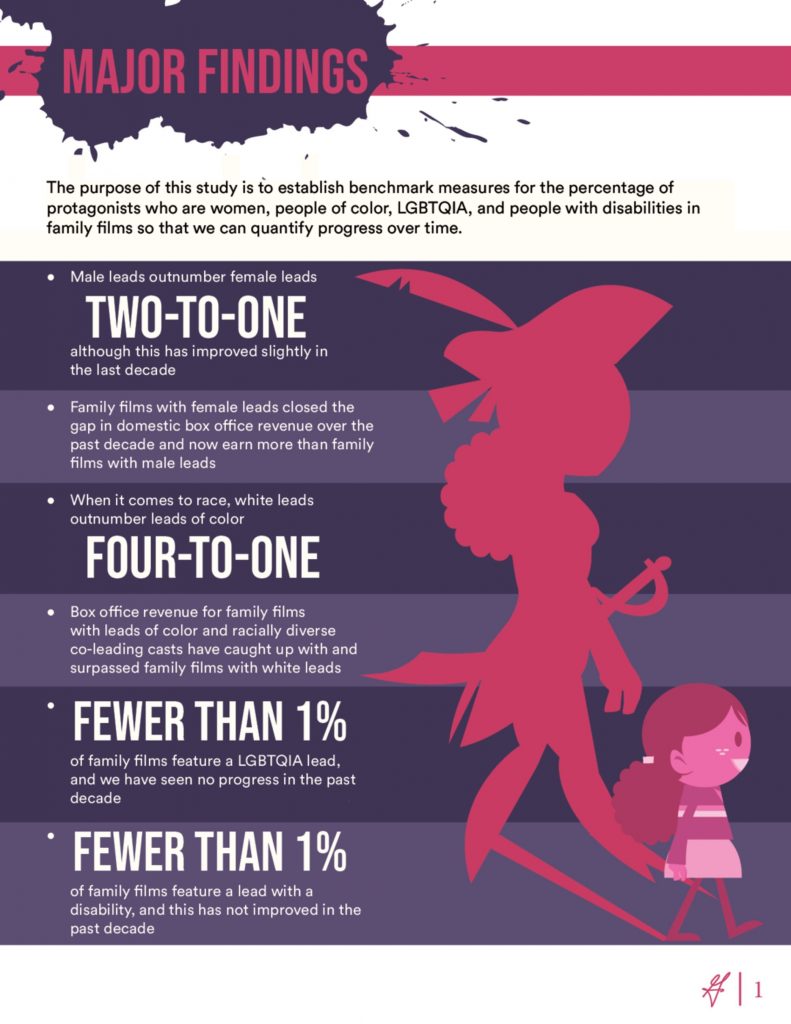LOS ANGELES — In the wake of #MeToo, #TimesUp and heightened awareness of the dramatic gender inequity on screen, family films are far from achieving parity. According to The Geena Benchmark Report, the U.S.’s top-grossing family films still feature more male leads, despite global box office earnings being higher for female-led films.
For the study, the Geena Davis Institute on Gender in Media at Mount Saint Mary’s University analyzed 1,115 characters from Variety‘s top 100 grossing animated and live-action family films between 2007 and 2017. Led by Dr. Caroline Heldman, Research Advisor for the Institute, the study examines the family films’ leading characters based on gender, race, sexual orientation and disability.
Women are 52 percent of all moviegoers according to a report by MPAA and 51 percent of the U.S. population but the Institute’s research discovered that within the last ten years, male leading characters still outnumber female main characters 2:1. Previous research from the Institute also revealed that male characters spoke twice as often as female characters in the top-grossing family films of 2017.

Family films with female leads increased box office earnings from $44.3 million in 2007 to $80.1 million in 2017 – a 55 percent gain over the decade. In 2016, female-led family films outperformed men at the box office for the first time by grossing $94.3 million compared to $88 million for male-led films, a 7 percent increase. This uptick repeats in 2017 and is a sign that female leads are closing the gap between male-led family films both domestically and internationally.
In 2007, male-led family films earned international revenue of $172.5 million compared to $90.1 million for female-led family films. Yet by 2017, family titles with female leads rose to $217 million in international revenue, just $18 millionbehind the $235.1 million earned by family films with male leads.
Gender is only one portion of this inequity. When examining main characters, the study revealed that a low 16.7 percent of leads were people of color in the last ten years and of that percentage, only 26 percent were women of color. With 39 percent of the U.S. population being of color, this is dramatic under-representation.
Yet, the study also found a positive trend in 2017. That year, family films starring leads of color outearned similar films featuring white actors by 14 percent, generating $11.5 million more in revenue.
The results for LGBTQIA and leads with disabilities are especially shocking and stagnant. Less than 1 percent of main characters were LGBTQIA or had a disability and there were so few leads with these identities that researchers were unable to draw intersectional conclusions about race or gender. These numbers haven’t improved within the ten-year period.
Institute Founder and Chair Academy Award Winning Actor Geena Davis has been championing industry change since 2004. “Movies do more than inspire us; they promote acceptance and awareness of people’s identities. When the stories we tell don’t reflect the intersectionality in our society, children learn that people of marginalized identities simply matter less in our culture.”
“Our report demonstrates to the industry how representation has changed in film, identifies gains and guides them to understand where dramatic progress is needed. Systemic change in order to achieve gender parity onscreen has been our focus since 2004,” states Madeline Di Nonno, CEO of The Geena Davis Institute on Gender in Media.
The full report can be downloaded here.







Add Comment